In December, Vertical began the search for the helicopter community’s favorite civil aircraft. We created a shortlist of 30 helicopters from the ages that have made a particular impression on us, and then invited you, our readers, to vote for your top three on our website. Each first place vote registered three points for that aircraft, a second place got two points, with one point for a third place. Thousands of you took part over the two-week voting period, and the emotions stirred by the contest were clear from the discussion it ignited on our social media pages.
We’ve tabulated the results, and you’ll find the helicopters with the 10 highest scores on the following pages. There’s something for everybody, with the list spanning about 75 years of rotorcraft technology.
Any pilots read Vertical? You bet — which helps explain the high ratings forwhat can be considered “pilot’s helicopters,” starting with the agile MD 500 at the top of the pile. The aircraft is also the only helicopter on the list that has seen almost 50 years of unbroken production since Hughes unveiled the original Hughes OH-6.
The 10 include two pioneering rotorcraft designs of the 1940s, five 1960s and 1970s civil aircraft that leverage U.S. military programs, and three clean-sheet designs that utilize technology from multiple sources.
Vertical flight is a passionate industry and almost everyone associated with it has a favorite aircraft (or three). Whether that’s because it’s the aircraft you fly today; one that triggers a particularly fond memory; or simply because it has exceptional capabilities, we all have our reasons for holding one aircraft above the others. The top 10 is notable for its absentees as much as its inclusions — did your favorite make it in?
1. MD Helicopters MD 500
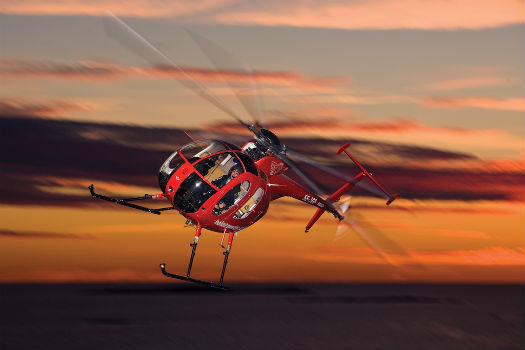
Claes Axstal Photo
The MD 500 traces its origins to the Hughes Model 369, which was developed by a team lead by Malcolm Harned in Culver City, Calif., to compete in the U.S. Army’s Light Observation Helicopter (LOH) competition (as the YOH-6A “Cayuse”). The prototype first flew in February 1963, and set 23 world records by the end of 1966. It was smaller, faster and lighter than its LOH rivals and Hughes won an initial U.S. Army contract in May 1965 for 714 helicopters, with the aircraft quickly entering combat in Vietnam.
The commercial Hughes Model 369H was certified in November 1966, powered by an Allison 250-C18A. Pilots quickly fell in love with its high-speed performance, which included a maximum cruise speed of 130 knots (150 mph) — and many lives were saved by the aircraft’s highly crash-resistant teardrop-shaped A-frame cabin design.
Since 1963, the MD 500 family has been built by Hughes, then McDonnell Douglas and most recently MD Helicopters, Inc. The United States Federal Aviation Administration (FAA) has certified 12 variants, with takeoff weights ranging from 2,400 pounds (1,089 kilograms) to the MD 600’s 4,100 pounds (1,860 kilograms). The new six-blade MD 540F (powered by a Rolls-Royce M250-C47E) is in development.
2. Sikorsky S-92
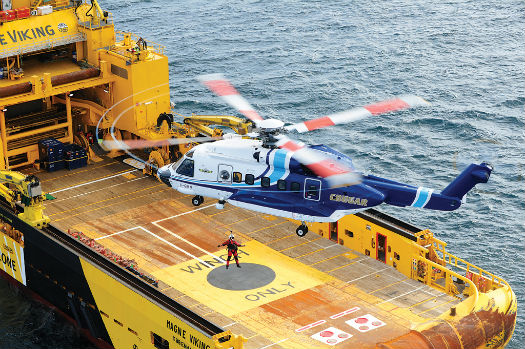
Mike Reyno Photo
The Sikorsky S-92 was developed in the 1990s as a large capacity commercial and military helicopter. The aircraft was launched at the 1995 Paris Air Show, and first flew in December 1998 in West Palm Beach, Fla. It was certified by the FAA in April 2002 (to carry a maximum of 19 passengers) with the first delivery made to launch customer PHI, Inc. at the 2004 Heli-Expo show in Las Vegas.
Five international partners in Japan, China, Taiwan, Spain and Brazil feed major components to the S-92 final assembly line in Coatesville, Pa.
The S-92 has become a major offshore workhorse in the North Sea, Atlantic Canada, the Gulf of Mexico and off Brazil and China, flying up to 300 miles out to sea. Use as a search-and-rescue (SAR) helicopter is also growing, with S-92’s Rotorcraft Ice Protection System (RIPS) invaluable in this role.
Onshore, the S-92 has supported U.S. military logistics in Afghanistan.
Canada placed the first military order for 28 CH-148 Cyclone anti-submarine models in 2004, and in 2014, Sikorsky was selected to provide the S-92 as the next U.S. Marine One presidential helicopter.
3. Bell 206 JetRanger
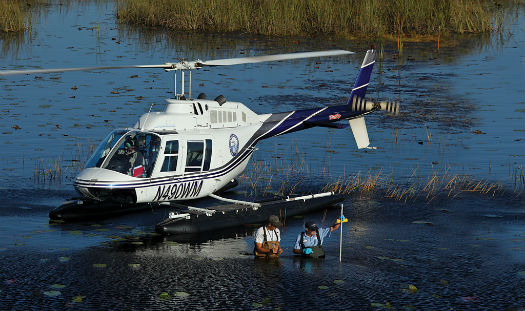
Sheldon Cohen Photo
The JetRanger started life as the ugly duckling Bell YOH-4A, competing to win the U.S. Army’s LOH competition — but after losing the competition to Hughes, it was redesigned by Dwayne Jose’s commercial marketing team with a wider cabin, redesigned nose and windscreen, and new rear fuselage with a baggage compartment — and in the process became a swan.
The first Bell 206A flew in January 1966, was certified by the FAA in October that year, and the first two aircraft were delivered just three months later. In the late 1960s and early 1970s, the JetRanger pulled ahead of the Aerospatiale Alouette II, Hughes 500 and Fairchild Hiller FH1100 to become the most widely flown light turbine helicopter.
Bell moved the JetRanger production line to Mirabel, Que., in August 1986 and delivered the last civilian aircraft in 2010.
The JetRanger’s FAA type certificate encompasses 10 members of the family: Bell Model 206 (YOH-4A), 206A, 206A-1(OH-58A), 206B, 206B-1, 206L, 206L-1, 206L-3, 206L-4, and the 407.
4. Airbus Helicopters AS350 AStar
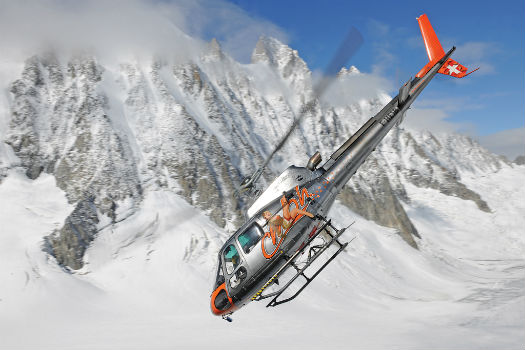
Anthony Pecchi Photo
In the early 1970s, Aérospatiale embarked on the development of a new helicopter design to follow the success of the single engine SA 318C Alouette II and the SA 341G Gazelle.
The AS350 family was a new generation design, incorporating a simplified structure, the use of automotive parts and instruments, and the extensive use of composites to reduce the number and cost of structural parts. A simple gearbox with half the parts of an Alouette gearbox was developed, and the glass fiber StarFlex rotorhead had half the parts and weight of the rotorhead on the Gazelle.
The AS350 was priced at $235,000 when unveiled at the 1977 HAA Convention in Anaheim, midway between the price of a JetRanger and a LongRanger.
The AS350’s smooth ride and wide field of view made it popular with pilots and passengers, and sales soared with the debut of the AS350 BA, AS350 B2, and AS350 B3 models featuring upgraded rotor and dynamics systems, more powerful Turbomeca Arriel engines and later a FADEC, with the EC130 introducing a wider cabin and Fenestron ducted tail rotor to the aircraft family.
The AS350 is built in Marignane, France; Columbia, Miss.; and by Helibras in Brazil.
5. Sikorsky S-76
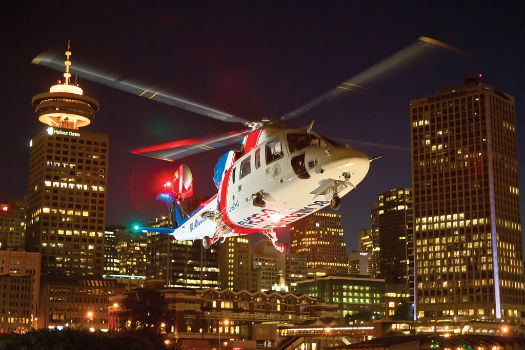
Heath Moffatt Photo
The S-76 was the first Sikorsky helicopter designed from the ground up for the civilian market. The fast and sleek design was developed to increase Sikorsky’s share of the expanding offshore and executive markets, and offered the range, speed, payload, operating economics and comfort desired by customers in both sectors.
In the offshore role, the S-76 could swiftly fly two pilots and 12 passengers on long overwater missions requiring instrument flight rules (IFR) capability and an emergency flotation system. In the executive role, the S-76 offered a quiet cabin and retractable landing gear, sleek styling and the performance required to replace fixed-wing business aircraft on short to medium distance trips.
The prototype S-76 first flew in March 1977 in West Palm Beach, Fla., and launch customers included Air Logistics (now Bristow) and Okanagan Helicopters (now CHC), with the first new-generation S-76D entering revenue service in early 2014.
Over its production life, the S-76 has been powered by four different engines to enhance performance, range and reliability: Rolls-Royce/Allison (250-C30), Turbomeca (Arriel), and Pratt & Whitney Canada (PT6B and PW210S).
6. Columbia Model 234
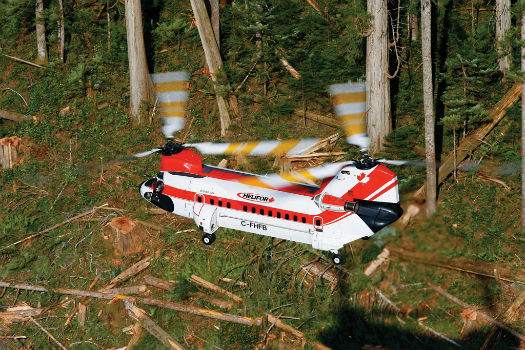
Jeff Wilson Photo
Boeing launched the commercial version of the military CH-47 Chinook in November 1978, with an order from British Airways Helicopters (BAH) for use in the North Sea.
The Model 234LR made its first flight at the Boeing plant in Philadelphia in August 1980, was certified by the FAA in June 1981, and entered service with BAH in Aberdeen, Scotland, the next month.
The 234 introduced composite rotors, a larger nose to accommodate weather radar, and longer overhaul intervals to help reduce operating costs.
Columbia Helicopters bought its first Model 234 from British International Airways for use offshore in Alaska in 1985. It bought further 234s from British International Airways, Helicopter Services of Norway, Trump Airways and Boeing.
Columbia and its Canadian affiliate Helifor are the only commercial operators of the Model 234, which has been used around the world for logging, construction, wildfire management, mining support and petroleum exploration.
Columbia acquired the Type Certificate for the Model 234 from Boeing in 2006.
7. Vought-Sikorsky VS-300
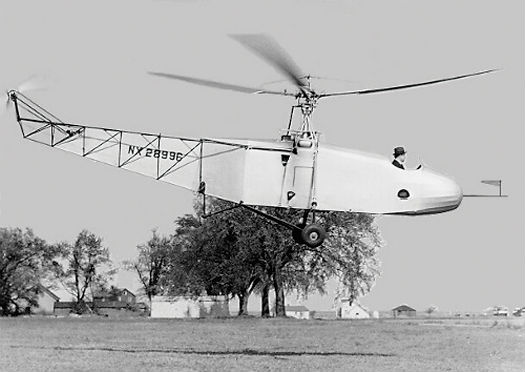
Sikorsky Photo
The Vought-Sikorsky VS-300 made the first officially recorded sustained helicopter flight in the Western Hemisphere, and established the design configuration that has become standard for most modern helicopters.
Igor Sikorsky built two unsuccessful helicopters in Russia in 1909, prior to designing fixed-wing aircraft in Russia and the United States.
Development of his third helicopter began in 1939, and Sikorsky hovered the VS-300 untethered for the first time in Bridgeport, Conn., in May 1940.
The initial VS-300 design had a welded tubular steel fuselage. Its 75-horsepower Lycoming engine drove a three-blade rotor, as well as three auxiliary rotors placed at the rear of the fuselage for directional control — two on outriggers rotating horizontally, and one at the extreme rear rotating vertically.
During 1941, the VS-300 set an international helicopter endurance record of one hour, 32 minutes, and 25 seconds; demonstrated repeated water landings and takeoffs when mounted on rubber floats; and solved all the fundamental problems of control and stability.
The final configuration of the VS-300A had a 90-horsepower Franklin engine powering to a three-blade main rotor and a single anti-torque tail rotor.
Reflecting on the the VS-300, Sikorsky said, “The helicopter approaches closer than any other (vehicle) to fulfillment of mankind’s ancient dream of the flying horse and the magic carpet.”
8. Sikorsky S-61
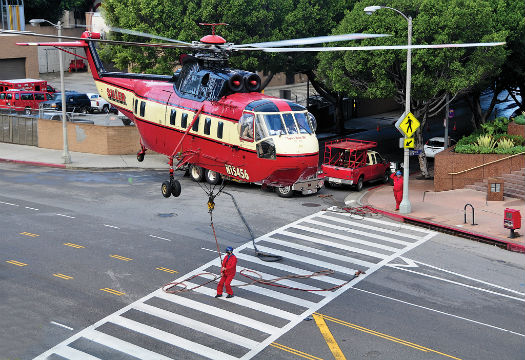
Skip Robinson Photo
Once a mainstay of the heavy-lift and offshore market, the Sikorsky S-61 got a new lease on life in the 21st century when it provided airlift support to the U.S. government in conflict zones.
The S-61 is a derivative of the twin-engine HSS-2 Sea King (SH-3) developed as a submarine hunter in the 1950s for the U.S. Navy. The S-61L model, first flown in November 1961, was designed as a helicopter airliner with a longer cabin than the HSS-2. It could seat 30 people and had an under-floor baggage hold and fixed landing gear.
The S-61N, first flown in August 1962, was designed for overwater use and had a boat hull and large external floats (called sponsons).
From the mid-1960s to the late-1980s, the S-61N was the backbone of the North Sea fleet, with many retiring offshore aircraft finding new work in the SAR, utility, firefighting and heli-logging sector.
Carson Helicopters developed new composite main rotor blades that enhanced the performance of the S-61 family, and Sikorsky later hired Carson to refurbish civil S-61Ns and ex-military SH-3s as Sikorsky S-61Ts for U.S. government transport use in conflict zones.
9. Bell 205A-1

Mike Reyno Photo
The Bell 205A-1 is the civil certified version of the Bell UH-1D/H Iroquois, which was a stretched derivative of the Bell Model 204 and UH-1B “Huey” developed for the U.S. Army.
The Bell 205A-1, powered by a Lycoming T53-13, was certified to carry one pilot and 14 passengers with a maximum takeoff weight of 9,500 pounds, or 10,500 pounds carrying an external load. The aircraft quickly saw success in the U.S., Canada, and overseas, flying offshore and utility missions.
In the 1970s and 1980s, the helicopter also became popular for airlifting heli-skiers to untouched mountain slopes and for transporting initial attack crews to wildfires.
The aircraft’s firefighting “kit” was also enhanced with the development of the SEI Bambi Bucket, belly tanks and water loading systems.
Over its operational life, the Bell 205A-1 has benefitted from a number of performance enhancements, including a powerful Honeywell T53-17 engine and a Bell 212 rotor system, as well as the addition of the BLR Fastfin and dual tailboom strakes.
10. Bell 47
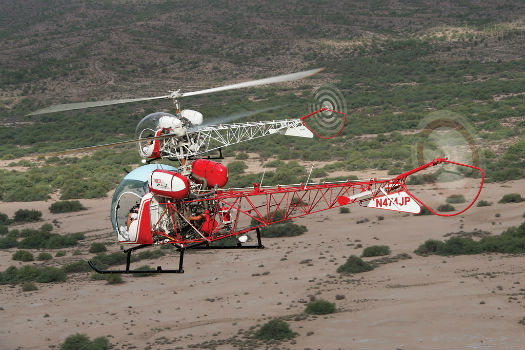
Dan Megna Photo
The Bell 47 was developed by inventor Arthur M. Young and his team with the financial backing of Larry Bell, founder of Bell Aircraft of Buffalo / Niagara Falls, N.Y.
Young reached a deal with Bell in late November 1941 to build two prototypes with Bart Kelley, a childhood friend with two physics degrees (later VP of engineering at Bell). A third prototype became the basis for the Bell 47, which was certified by the CAA (the precursor to the FAA) in March 1946.
The first Bell 47s had open cockpits, with the aircraft’s iconic bubble canopy and skid landing gear introduced in the late 1940s.
The Bell 47 underwent continual product improvement during its 30-year production run, during which almost every technical aspect of the helicopter was improved upon.
In December 2009, Scott Churchill bought the type certificates for the Model 47 family from Bell Helicopter, and a new company, Scott’s-Bell 47 Inc., is preparing to put a modern version of the aircraft back into production, powered by a Rolls-Royce RR300 turboshaft engine.





